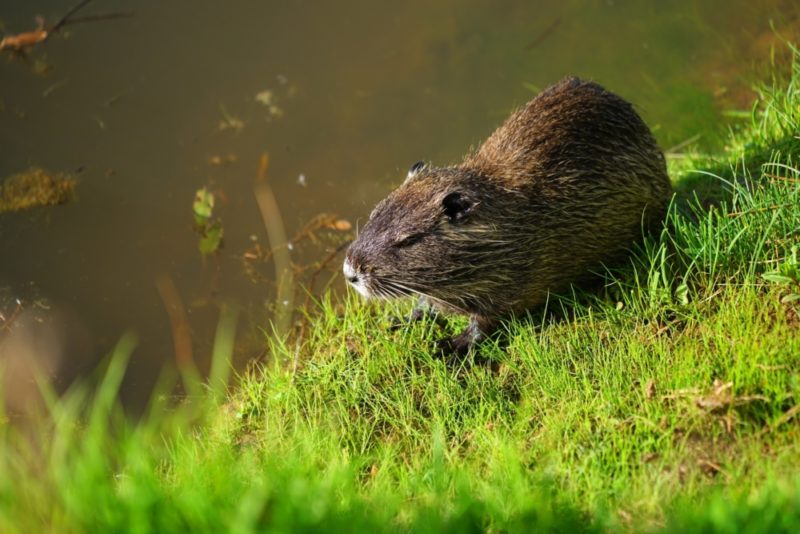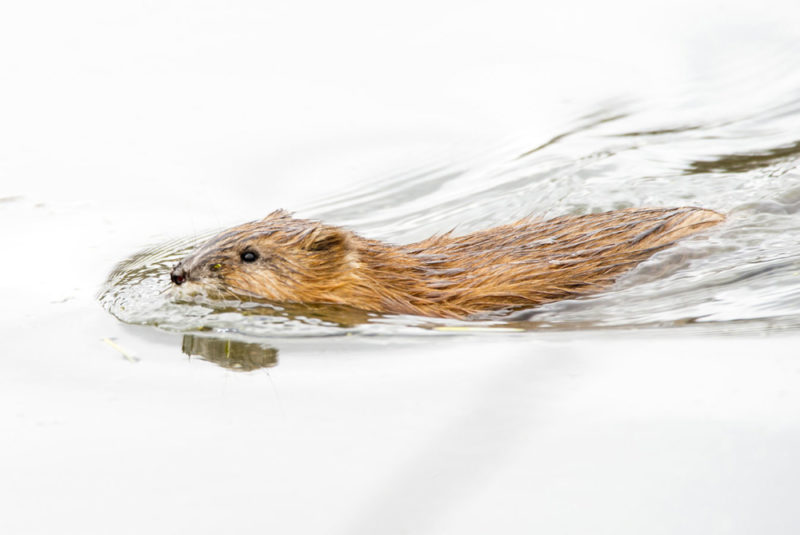These small animals can easily be confused with rats. But if you look closely, you can notice a number of differences, and, first of all, it is a beautiful and warm fur, for the sake of which individuals were introduced to Russia. What the muskrat eats, where it lives, why its fur coat is so valuable - about all this - further.
Material Content:
Description and characteristics of the animal
The beaver’s younger brother, or the musky rat, is often called the muskrat. But biologically it is closer to field mice, and therefore refers to their subfamily, being the only representative of the muskrat genus. The first description of the animal was given in the XVII century by C. Smies, who explored the animal kingdom of Virginia, as mentioned in the book entitled “Map Virginia”. Since then, biologists have discovered 3 types of muskrats and several subspecies. But the differences between them are obvious only to a specialist.
Nature tried and perfectly equipped the animal with everything that it needs for a comfortable existence both on water and on land:
- tail flattened on the sides, covered with sparse hairs and small scales with a comb of long, hard-to-touch hair from below, which allows the animal to swim quickly. In an hour, the muskrat can overcome up to 8 km;
- streamlined thick body with a short neck and a small muzzle of the head promotes maneuverability in the water;
- the muscles of the animal have an increased content of myoglobin, a large presence of hemoglobin is noted in the blood - all together gives the supply of oxygen necessary for diving. The muskrat is capable of being under water for up to 17 minutes;
- the rodent's body can regulate the flow of blood to the tail and limbs, and therefore they are colder in the individual than the body;
- the peculiar structure of the hind legs helps to swim well: there are small membranes between the fingers;
- small ears are strongly pressed to the head and only slightly peep out of the thick undercoat;
- expressive eyes are small and in appearance resemble high-set beads;
- powerful incisors, isolated from the mouth by the lips, allow her to successfully cope with any surface and underwater food, without drowning in water.
Fur is also noteworthy: it has a soft thick and lush undercoat, not permeable to water, with coarse outer hair. Muskrats are large neat. Combing and lubricating a luxurious fur coat with fat secretions is a mandatory daily procedure.
The color of the fur in animals varies and can have shades of light ocher or almost black, but more often - brown-chestnut, lighter on the abdomen. If you look at the fluffy muskrat, it seems that you can sew a whole hat from the skin of one animal. But this is not so. Although it is the largest of all voles, even an adult rodent does not weigh more than 2 kg. The body length is quite impressive, reaching 35 cm, the tail is slightly smaller. In general, it is about 60 cm.
Muskrat is a native of America, its northern continent. The animal began its victorious march through Europe in 1905, when in the vicinity of Prague 3 females and 2 males were released. The conditions for their existence were favorable - a lot of food and almost no natural enemies. The animal is quite prolific, so it began to spread quickly.
Muskrat came to Russia in 1928 from Finland. They brought it with the purpose of breeding for the fur industry. At that time, the habitat was small - the northern islands and the taiga zone. Now the muskrat can be found wherever it has food and suitable living conditions.
The most valuable thing in the animal is the fur. The Indians appreciated its high quality and sewed warm clothes from skins. They used muskrat meat for food, calling it a water rabbit. In other countries, muskrat is also a valuable fur-bearing animal. Fur coats from such fur are always warm and very socks.
Muskrat Habitat
The animal settles near the water, choosing non-freezing shallow reservoirs. Muskrat can be found along the banks of shallow rivers, near ponds and lakes overgrown with reeds, but most of all she likes freshwater swamps. A prerequisite is the required number of coastal and aquatic plants - its main feed. On land and in water, the animal stays for approximately the same amount of time, for which it is often called a semi-aquatic rodent. On earth, such an individual is quite slow, but feels great in the water.
Semi-aquatic rodent lifestyle
The hours of the largest muskrat activity are the evening when the sun has already set, and the early morning. It is at this time that she absorbs food.
This animal is a skillful builder. She can not be compared with a beaver - not the size and strength, but the basic principles of building housing they have the same:
- entry below water level;
- burrows, where it is possible to dig them on a gentle shore, reach 10 m long, on a steep one - up to 3, which is much longer than that of beavers;
- if there is no place to build a hole, the muskrat chooses any solid foundation for its hut, using stems of water plants as a building material, fastening them with sludge.
Shelter of the muskrat serves her for more than one year. Every spring, the animal carefully repairs and updates it. Some long-existing huts are up to 4 m in diameter and up to one and a half in height. In animals that have recently begun an independent life, the hole is simple - with one entrance and a camera. Gradually, the house is overgrown with additional openings and branches. A well-thought-out ventilation system appears.
The design of such houses provides a nesting chamber, which should not be flooded with water, as well as an open fodder area connected to the pantry, where the prudent animal makes reserves for the winter. The building can also be two-story with two nesting chambers connected by a passage. Such a structure is erected in cases where the water level in the spring is very variable. In the nesting compartment it is always warm, even in winter the temperature in it does not fall below 0 degrees. The house is being built very quickly, sometimes one night is enough.
It happens that the animal arranges for itself a simple nest of improvised materials, if the reservoir in which it lives is frozen through and the owner simply cannot get into his house. The animal is also active in winter: it makes passages in the snow, dives under the ice, for breathing it breaks through "vents" - special small holes.
Muskrat - a family animal. A single house is the exception rather than the rule. More often you can meet a "village" of several lodges. Each family has its own fodder plot. Strangers are not allowed there. Males mark the territory with a special musky secret that the inguinal glands produce. By colds, aggressiveness is weakening and a stranger may be allowed to stay in the family nest for the winter.
In spring, the growing muskrats rush in search of new fodder land, sometimes making long walks.
Diet in nature
The river muskrat is mainly a herbivore.
Plants prevail in its diet, which can be found along the banks and in directly in the water bodies:
- reeds;
- cattail;
- sedge;
- horsetail;
- arrowhead.
In the spring, she likes their young stems. When the grass coarsens, it eats everything that can be found at the base of the roots. If near the habitat there are areas with crops of cultivated plants, especially rice, the animal will eat in the fields, in the garden, in the vegetable gardens. He loves root vegetables, greens, fruits: apples, pears, plums.
In nature, an omnivorous rodent eats up to 300 wild and up to 50 cultivated plant species, including toxic ones such as marsh milestone.
What does the muskrat eat in the pond? She does not disdain animal feed: shellfish, fish, frogs. But in the warm season, the proportion of such food in the diet of the muskrat is small, although constant.
Differences in the diet of muskrat in winter and summer
In summer, the animal can choose the most tasty food from all natural plant diversity. In winter, only stockpiled reserves and rhizomes found in the earth help out. But animal food in a pond or other body of water is present year-round, unless it freezes completely. The lack of plant food in winter causes the muskrat to increase the proportion of animal feed.
Reproduction and care of offspring
As soon as the spring sun warms up, a crucial period begins in the life of animals - reproduction. Mating games begin with courtship of males for females. At this time, males are very excited, emit a loud squeak, the production of musk by the glands increases. Mating occurs on land or in shallow water. This is followed by a joint bath and rest.
Pregnancy in females lasts about 26 days. Babies, and there can be up to 8 of them in a litter, are born blind, naked and toothless. The weight of each is only about 20 g, because the kids need vigilant control and care. Muskrat's parental responsibilities perform very well. There is always a lot of food in the nest - this is the merit of the male, and offspring through the efforts of the mother are always well-groomed.
The offspring of the muskrat are growing rapidly. The teeth appear on the third day, first they are white, then they turn brown. From 13 days, eyes open, and the baby is already trying to move independently. On day 18, he is already able to bite a possible enemy. A little earlier, they begin to swim and try ordinary food, although they are still fed breast milk. In a month, growing muskrats begin self-nutrition. Such an animal is already quite capable of building its own house and storing food.
In a suitable climate, the female can bring up to 3 broods per season. Yet the cubs exist together in the same family home until the mother forces him to leave. In nature, a fluffy rodent rarely lives up to 4 years.
Interesting Facts
A lot of interesting facts are connected with the muskrat.
- Native American tribes believed that it symbolizes cunning and real male friendship.
- In captivity, the animal lives almost 3 times longer.
- In some countries, it is considered a pest due to the fact that it successfully undermines dams and other protective structures. They ruthlessly destroy individuals.
- This rodent serves as a carrier of a number of diseases that are dangerous for humans and domestic animals: Omsk hemorrhagic fever, paratyphoid fever, tularemia, salmonellosis, coccidosis, paratyphoid fever.
- In the reservoirs near which the rodent lives, the oxygen regime is favorable for wintering of fish because of the ice vents arranged by the animals.
- For unknown reasons, the population of the population cyclically decreases approximately every 7 years.
The muskrat is a very plastic species, which, after introduction into a new biological system for itself, managed to adapt to it without causing much harm.


















